Of knots and whorls
by Caitlin Franzmann
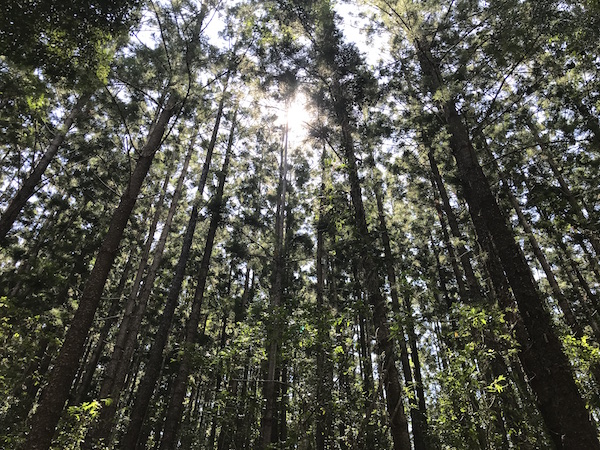
A hoop pine is slow growing and, I’ve been told, can live up to 450 years (I think more). Each season, new branches radiate laterally from a central bud at the tip. Whorls and knots tell stories of unfolding patterns, disruptions, and of old growth embedded in new plant tissue.
After a recent clear fell in the plantation, the foresters found a huddle of seedlings overlooked for decades. Contained within vintage galvanised tubes, the plants were waiting patiently for the right conditions to thrive.
The aim of Mistra Environmental Communication at USC is ‘to enable new kinds of practice and processes to support transitions towards sustainable futures’. So why have I found myself, as the program’s artist in residence, continually looking to the past?
The message I’m receiving from many whom I’ve met on this residency journey is that the past is within me, within place, and within all living beings, folded in to a layered and relational meshwork of ‘now’. As Margo Neale states, the understanding that ‘time and place are infinite and everywhere’ is embedded in the Aboriginal worldview (1). I am guided by this worldview into a collective mindset as I walk, listen, converse, wonder and imagine futures on Kabi Kabi/Gubbi Gubbi Country. From this position, I am more inclined to ask, as Marcus Bussey encourages, how does the past shape my interactions? What does my culture and conditioning enable or disable?’(2). And to consider as Avril Bell proposes, what memories, narratives or forgetting require unsettling? (3).
These questions require slow and intimate approaches. They are questions that will likely generate more questions and a chaotic ecosystem of lively interactions, knots and whorls that will continue beyond this two-months with USC. This offers some insights into the approaches to fieldwork and research I have engaged with during this residency and what has been revealed, felt or pondered along the way.
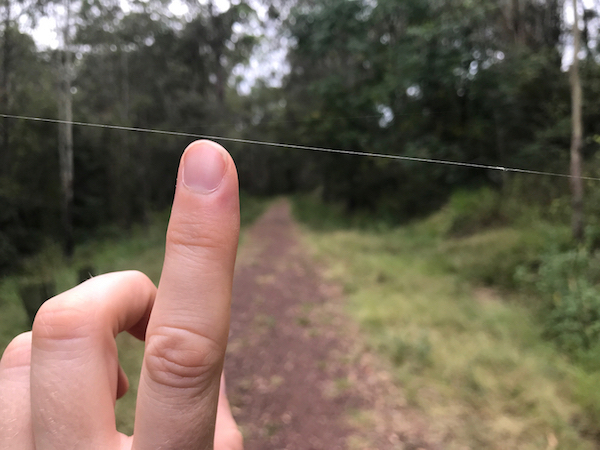
Origins
In 2019, I was gifted a book titled The Relationship is the Project. A book of ‘provocations, tools and practical tips’ (4) for creative practitioners working with communities. In the chapter ‘First Peoples First’, Genevieve Grieves discusses the impacts of ongoing colonising structures within this country, now called Australia. and highlights that the ‘most important relationship for an interested worker-of-change is relationship to self’ (5).
Grieves’ tip, ‘know your origin story’ (6) penetrated my bones. I could feel her provocations resonating as I wrote my Mistra residency proposal. Who am I in relation to this land – Kabi Kabi/Gabbi Gabbi land – and its people? What are our shared histories? What is my culture and how does it influence my actions? And furthermore, the necessary questions that Shannon Brett encourages us to ask ourselves about the land that we live [or roam] – “what happened here?” and “who on Country should I go to for permission for all the things that I do upon this land?” (7).
I was recently asked to share a story about my ancestry for Meander International Platform – “a forum where members of four collectives and initiatives situated in different parts of the world come together online every month, to exchange ideas” and propose scores (instructions) for each other to “examine our relations to our environments and our fellow living beings” (8).
Not quite knowing where to begin with my mixed European settler heritage, I jumped in my car to visit a bushland located on Gubbi Gubbi/Kabi Kabi Country where my Danish great-great grandfather is buried. Just as I was uncertain where to begin, I wasn’t sure of where I was going.
Lost on a remote gravel road in Brooloo, I serendipitously met a local retired geography teacher, Ian Stehbens. It turned out that his grandfather and my great grandfather worked together in the local timber mill. During this residency, Ian has guided me around the Mary Valley region, sharing stories of his life growing up in Imbil, his interest in geology and history, and his later years dedicated to conservation of ecologically and culturally important ecosystems within local ‘State Forests’(9). Ian took me into the forest plantations with rows of native hoop and bunya pines dedicated for timber extraction. He showed me riparian corridors, patches of ‘virgin’ forest and views of ridgelines that timber getters were unable to access. He showed me a road cutting that reveals a fault line of serpentinite rock, which I would likely have bypassed if not for his geologist’s eye. He recognised the rock’s snake-skin-like composition of minerals and pointed out the radical change in ground and vegetation types on either side of the metamorphic vein. He noted that this is where ocean once met land.
I left our first encounter with a photo of my great grandfather rolling logs on Moocooboola (Mary River), surrounded by a dense meshwork of canopies and vines. Ian took me to where this photo was taken, now impenetrable with introduced plants that also hold stories of people, places and colonisation.
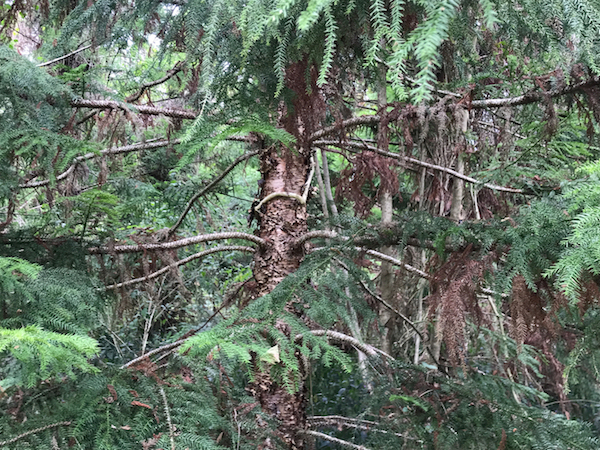 |
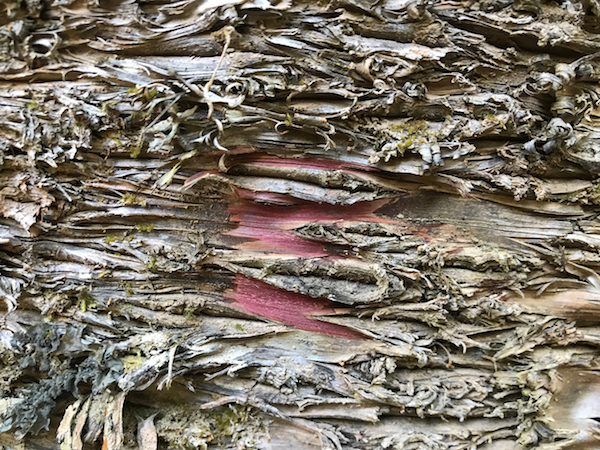 |
|---|---|
| Hoop Pine, Imbil State Forest plantation | Peeling bark of the Hoop Pine tree |
Unforgetting
I’ve been learning about my Danish ancestors. In 1870, they travelled to what they understood as Queensland—a new colony seeking European settlers (non-British and yet notably white) to ‘populate the land’ (10).
Widening the lens beyond my family and settler histories, I’ve also been learning that, as my ancestors arrived on Gubbi Gubbi/Kabi Kabi land as ‘free settlers’, the Gubbi Gubbi/Kabi Kabi people, who had survived the violence of frontier colonialism, were subject to ongoing racism and government regulations that controlled almost all aspects of their lives.
After labouring on a sugar plantation, timber-getting in Tiaro, and then a short spell of gold fever in Nash’s Gully, my great-great-grandfather ‘selected’ land in 1888 at the junction of Moocooboola (Mary River) and Yabba Creek. As with most colonists, his relationship to the land was extractive and patriarchal. From some accounts, he was a hard man. He was also likely a hard worker with a wealth of small-scale crop farming knowledge established in very different ecological and climatic systems. He had little to no regard for the Kabi Kabi/Gubbi Gubbi people’s connection and rights to their Country established over millennia or for their deep knowledge and maintenance of its living systems.
Widening the lens further again and, paradoxically, focusing in on a microscopic scale, I became aware of stories embedded in the land and the diverse ecosystems of the region.
As I walk the carved out trail, I get to know the macadamia trees in their place of origin. I weave across rock pools, through riverine rainforest alive with sounds. I pass cedars, hoop pines and a bunya pines, one bearing the marks of toe holds used by Kabi Kabi/Gubbi Gubbi people. A singular spider web traverses the trail, borders are everywhere. The ridge presents a transition zone into a hoop pine plantation. The air here feels hushed.
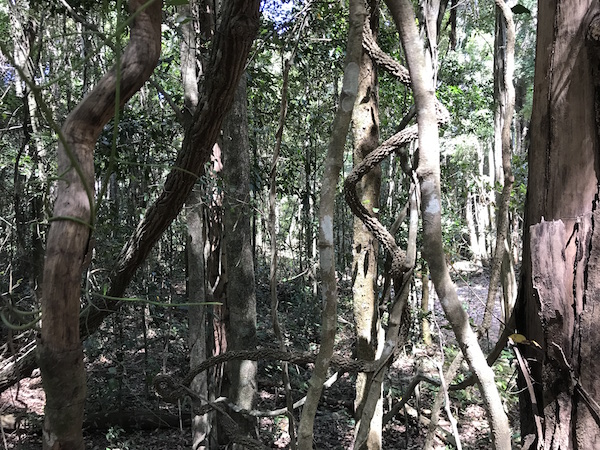 |
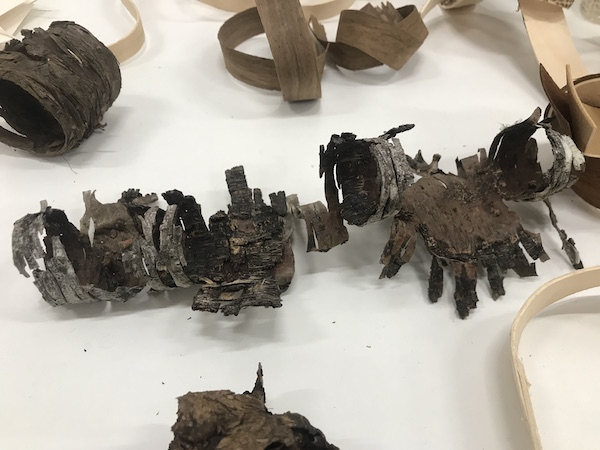 |
|---|---|
| Entanglements in vine scrub of Imbil State Forest | Circular form of hoop pine bark |
Recompose
The timber sign next to the stump is covered with lichen. I can only just make out that the stump was a Sydney Blue Gum tree that was pit-sawn in 1901 by my ancestors, the Myers brothers, to provide timber for the first Kenilworth School. The stump is both rotting and alive. I contemplate the roots that I cannot see. I feel grateful that this memorial is not cast in bronze. I sit with the moss and the fungi and ask, how do I transform what I am receiving into nutrient rich soil?
Word spreads quickly in a small rural town. Before long, I was having conversations with other locals of the Mary Valley region—a newly found relative, a recent immigrant, a third-generation farmer and foresters. At the same time, I listened to the creeks, the trees, the deer, the magpie geese, and the moss.
I also had the opportunity to chat online with PhD candidates of the Mistra program, Sara Holmgren and Sanna Barrineau, who generously discussed their research and interdisciplinary methodologies. Sanna is researching a multi-species approach to caring for futures, focusing on soil, inspired by scholars such as Maria Puig de la Bellacasa and Astrida Neimanis who traverse intersections of feminism, multispecies justice and environmental change. She pointed me toward The FEELed Lab, a collaborative and interdisciplinary lab that insists on 'the messy and necessary amplification of feminist, queer, crip, anticolonial, and antiracist perspectives to address the tangled challenges of social and environmental crisis’.
This approach to fieldwork feels familiar to me. Conversation, collaboration and co-creation have been integral processes informing the continual revolution of my thinking and practicing as an artist. Since 2018, I have been ‘rehearsing’ within the collective research program, Ensayos. We partner with existing ecological and cultural conservation initiatives and entangle artistic practices, social science methods and Indigenous movements with environmental research efforts that are already underway. The program was founded by Camila Marambio in 2010 in Tierra del Fuego, and we now work in other archipelagos in New York, Australia, and Norway, sharing concerns and exchanging methodologies for our eco-cultural work. Ultimately, we engage in a playful practice of expanding the possible.
These kind of labs and research programs, much like Mistra co-creation labs, practice addressing difficult questions through embodied knowledge, interdisciplinary and cross-cultural exchange and play. As FEELed lab suggests, the process, whilst difficult, ‘can also be affirmative and joyful’—nutrient rich soil.
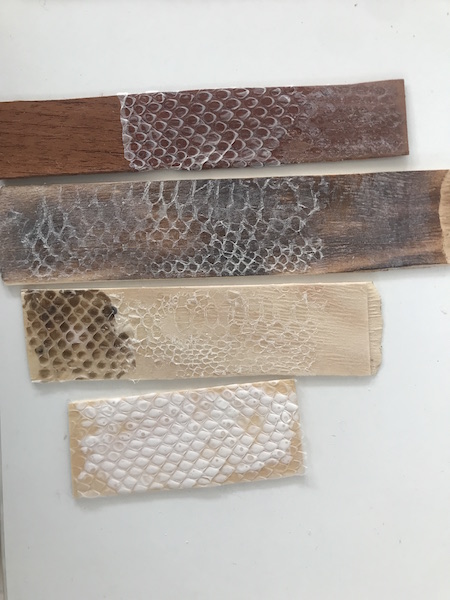 |
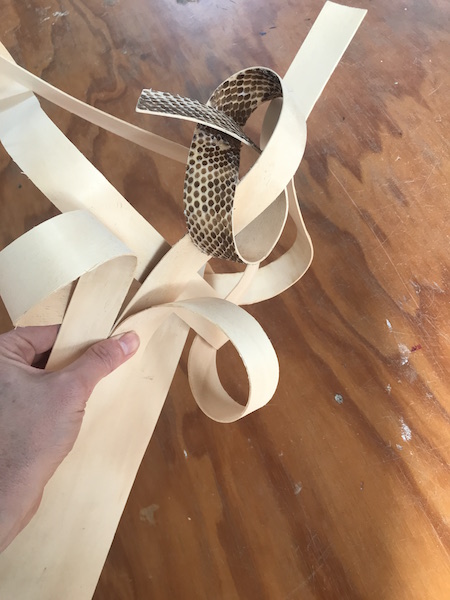 |
|---|---|
| Testing shed snake skin finishes | Twists and turns, testing form and finishes |
Cross overs
Sitting underneath the coastal she-oaks, we both appreciate the healing quality of the ocean breeze. Aunty Helena shares her stories and those of her family. At times, our stories intersect. Truths are told. Sometimes our thinking aligns and then differences are acknowledged, generously held. We contemplate co-creation—of sustainable futures, of art—and ponder the intercultural cross over space of our different responsibilities, desires and expertise.
I’m grateful to have been granted some time over the past month with Aunty Helena Gulash, Kabi Kabi senior woman, artist and advocate for Indigenous arts and culture. During this time, we began to question what might exist in the meeting place between our cultures. For Margo Neale, editor of the First Knowledges book series, cultural and intercultural differences can be a strength (11). This is reinforced by Country, that shows us again and again that abundance exists in the ‘ecotones’—the zones where different ecological systems meet.
Neale refers to fusion of western and Indigenous knowledge systems as the Third Archive and through the First Knowledges series she hopes ‘to incite and provoke expanded worldviews and unlimited other possibilities, including ways in which (the reader) can learn from the Aboriginal archive of knowledge embodied in Country.’ (12) For Margo, the series ‘reveals the significant influences that Aboriginal and Torres Strait Islander people have had on Australian society and history, and the enormous contribution they are making, which, in many ways, mainstream Australia is only beginning to recognise.’ (13)
As I recently sat listening to Jacob Birch speak of his passion for native grain foodways that sustained his Gamilaraay ancestors for thousands of years, I’m reminded that there are problems to remain aware of when bringing these knowledges together. This is particularly important within continuing systems that are extractive of First Nations knowledges and driven by economics. He offers the example of the bushfood industry, and macadamia in particular, that is dominated by non-indigenous interests. In the context of the Regenerating Country talk alongside Zena Cumpston, he proposes moving past ‘regenerative agriculture and into reciprocity—gift for gift’, transcending tokenism, and bringing community to the centre of decision making (14).
Reciprocity
All humans have reciprocal relationships with plants, whether consciously or not. Plants determine the atmosphere and climate. They enable life on earth and gift us food, medicine, materials and shade to rest and dream under. Humans plant seeds, nurture their growth and attempt to read their needs.
Plants: Past, Present and Future celebrates the deep cultural significance of plants to First Nations people and shows how engaging with this heritage could be the key to a healthier, more sustainable future. Co-author, Zena Cumpston highlights that ‘there is a wealth of information held within living communities that is just as important as historical accounts, if not more so’ (15).
I kneel with artist and friend Dominique Chen, pulling Singapore daisies from land on Yinibara Country that her family is tending and transforming with care. Along with other friends and family, we are preparing for a planting of natives from the general region–most are seedlings that hold stories of relationships, gifts and cultural knowledge. She tells me that they are from mob all over and some that are Gamilaroi, from her home, holding her culture in them.
Knowledge and experience is shared between neighbours on ways to manage the weeds. They lean into a systems approach–allowing some to hold space and recognising when others are being far too competitive in the context. Here, listening, truth-telling, reciprocity and recomposition is practiced without any need for recognition. It's a place of collective and embodied reading and healing of Country, of yarning and joyful imagining of possible futures.
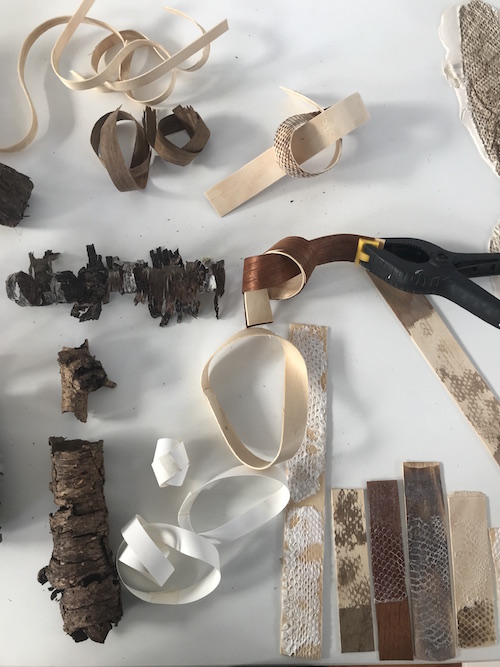 |
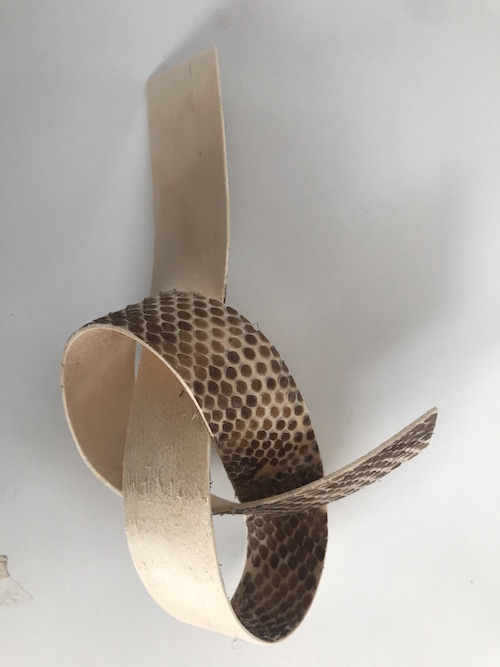 |
|---|---|
| Collected forms and sculptural studies | Testing shed snake skin finish |
The stories we water
As I continue to digest and compost what has been absorbed within the container of my body during this residency, I am now in the process of making and learning new timber forming skills from Sunshine Coast artist Ross Annels. Turning within and returning to materials I have gathered from the plantation forests and plywood factory floors, I find myself bending timber veneer into impossible knots, transforming snake skin sheds into powder and considering the resilient and unruly layers of hoop pine bark. My collaboration and conversations continue with local artists Dominique Chen and Libby Harward, with a participatory event titled ‘the stories we water’ to be co-presented at Metro Arts in June. Further updates and documentation will be provided here in the coming months.
Along with thanks to the entire Mistra Environmental Communication team, I’d like to thank my research assistant, author and educator Sarah Pye, for contributing her knowledge, experience and support during this residency.
Photo credit: Caitlin Franzmann. © 2023 All Rights Reserved.
References
- Neale, M and Kelly, L. 2020. Songlines the power and promise, Thames & Hudson Australia Pty Ltd, p.2.
- Bussey, M, 2023, Interview with Marcus Bussey: Co-creation for sustainable futures, MISTRA Environmental Communication; https://mistra.fsv.cuni.cz/interviews/interview-with-marcus-bussey
- Bell, A. 2022. Introduction: Studies of Critical Settler Family History. Genealogy 2022, 6(2), 49; https://doi.org/10.3390/genealogy6020049
- Lillie, J. 2020 The Relationship is the Project: Working with Communities, p.9
- Grieves, G. 2020 ‘First Peoples First’ in Lillie, J. 2020 The Relationship is the Project: Working with Communities, p.18
- ibid, p.19
- Shannon Brett, Kindred Spirits: People and Plants (Queensland: State Library of Queensland, 2021), p. 84.
- Meander, ‘Ancestors are the Future’, in Dietachmair. P, Gielen. P, Nicolau. P, 2023 Sensing Earth: Cultural Quests Across a Heated Globe, Antennae-Arts in Society Series, Valiz in collaboration with European Cultural Foundation, pp223-237.
- Emmersen, M. 2015, Too remote, too primitive and too expensive: Scandinavian settlers in colonial Queensland, Queensland Historical Atlas
- Neale, M and Kelly, L. 2020. Songlines the power and promise, Thames & Hudson Australia Pty Ltd, p.4.
- ibid, p.4.
- ibid, p.4.
- James, A. 2023 Regenerating Country, live with Jacob Birch & Zena Cumpston, 27 March 2023; https://www.regennarration.com/episodes/157-regenerating-country
- Cumpston, Z. Fletcher, M. Head, L. Neale, M (ed). 2022. Plants: Past, Present and Future, Thames & Hudson Australia Pty Ltd, p.83.
Caitlin Franzmann is an Australian artist who creates installations, sonic experiences and performances with a focus on place-based knowledge and embodied practices. During the AiR@USC, hosted by the University of the Sunshine Coast in Australia, she investigated regeneration of native plantation forests on the Sunshine Coast through engaging with Mistra-EC researchers and local community.